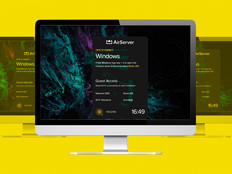“They were able to get all the information they needed from the video wall,” Yeloushan says. The same imagery could even be displayed at the EOC and the command center across town.
The city also replaced the processor, network switch and back-end infrastructure to manage the video walls in the real-time crime center and command center. It installed a Genetec video management system that connects to networks and displays in both locations. It also replaced all of the audiovisual controls in the command center, including lighting, overhead speakers and microphones.
Charlotte's EOC Is Now Better Prepared
The EOC first opened in July, and the video walls were the last components installed. “It was really cool to see how excited they were to have this new equipment,” Cody says.
As with any new technology, there was some initial discomfort among users, but they got used to it quickly, Yeloushan says. The system enables users to build templates for events. For instance, for a flooding event, the video wall would display televised weather reports, video feeds and dashboards showing water levels.
“Anybody who walks into the EOC can go and look for that template and just click on it, and it pulls up everything they need to see,” Yeloushan says.
Cody was amazed that there weren’t any major shipping delays considering the worldwide supply chain issues amid the pandemic. She credits CDW•G and CineMassive for that good fortune. “They knew the purchase orders were coming, they knew the contracts were coming, so they made sure they had the supply chain in the pipeline,” Cody says.
Equally important to the project’s success was the team’s adaptability, she says. “This year has taught me, if nothing else, that we have to remain patient, that we have to really stretch our flexibility. That’s the word of the year: flexibility.”
Charlotte Stays Flexible Ahead of RNC
Months before the Republican National Convention, Crystal Cody, public safety technology director for the city of Charlotte, N.C., began following the event’s hashtag on Twitter and set up news alerts so she could learn of changes as soon as possible.
Her team worked closely with CDW•G, which served as project manager, and with CineMassive, the manufacturer of the video walls and software. “I can’t say enough about what good partners they were,” she says. “There are a lot of vendors that would say, ‘You want to do what?’ ”
Due to the lockdown in the spring, most meetings were virtual. “We would get on the calls, and the CDW•G project manager was always like, “OK, what are we doing today?’” Cody says. “She was always very organized and really kept us on task. There weren’t any big gotchas. No one came away from the meetings like, ‘There’s just no way we can get this done.’ That was important — to keep the team morale going.”
Charlotte needed to have the command center completed before the convention, but the city also wanted it operational for other events, such as Independence Day and other celebrations.
“Everything was just so volatile at the time,” Cody recalls. “We didn’t know when we could close the command center and take it offline for a week and a half — but we worked through it.”










